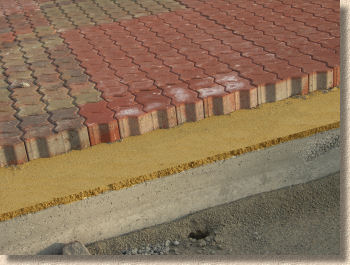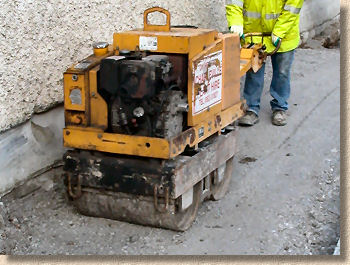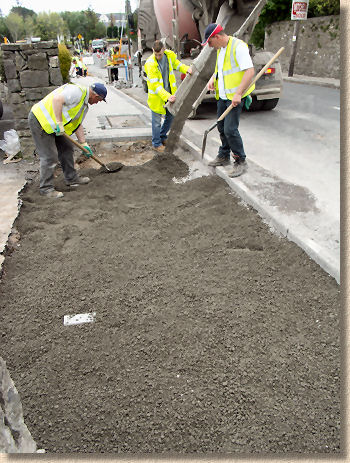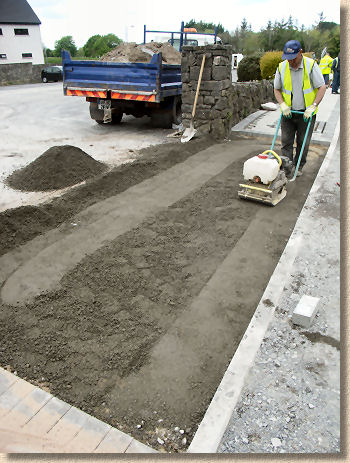Introduction:
An urban myth is gaining currency within the residential block paving installation trade. There is a growing trend for supposedly professional contractors to claim that a concrete sub-base is a better option than a traditional unbound granular aggregate sub-base.
It should be apparent that a concrete base must cost more than an unbound sub-base. A flexible sub-base consists of granular aggregates , while a concrete base comprises granular aggregates bound together with a cement. Roughly speaking, aggregate costs around 25 quid per tonne while cement is closer to 160 quid per tonne.
So, the key question: why is the contractor recommending a technique that is more expensive than that normally recommended? Is it sound advice or is there a distinct whiff of bovine excrement?

What's wrong with unbound?
In a word: nowt!
It is widely accepted that, for a typical residential driveway, a traditional granular unbound sub-base, when correctly installed , is more than adequate. On sites where there are problems with the sub-grade , such as boggy or made-up ground, running sand, etc., a bound base laid over a sub-base is often an elegant solution, but as a rough rule of thumb, there needs to be a sound site-relevant reason why a concrete base is preferred to an unbound sub-base.
The key phrase in the preceding paragraph is that bit about being 'correctly installed'. All too often, a sub-base and/or the overlying pavement fails because it was never properly constructed. When a driveway has ruts, or when it has humps and hollows, it's usually a safe bet that the sub-base isn't up to the job, and that is often due to the fact that far too many installers have little or no genuine understanding of how to correctly construct a sub-base, and so, to cover-up for their appalling lack of skill, they resort to using a concrete base, effectively over-engineering because they lack the competence to build a very basic pavement layer.
The most commonly encountered reasons for failed sub-bases beneath residential block paved driveways are:
- 1 - Insufficient depth
- 2 - Incorrect materials
- 3 - Inadequate compaction
Insufficient depth usually results from a combination of can't-be-arsedness and penny-pinching. The contractor decides not to dig to an adequate depth because it's too much trouble and the client probably wouldn't know any better, and every 20mm cut from the dig depth is 20mm less cart away and 20mm less aggregate to buy in.
Incorrect materials is nearly always down to penny-pinching. Rather than use regulated quality Type 1 granular material, the contractor can get hold of crushed brick or concrete, road planings, or ballast at a lower price and, once again, how many clients would know the difference?
Inadequate compaction is down to lack of training. All too often, a contractor will use the same lightweight plate compactor to settle the blocks and jointing sand and to allegedly “thoroughly compact” 100mm plus of granular material. The relevant British Standard requires a plate compactor to have a mass of not less than 75kg if it is to be used to compact a sub-base. Most plates used by residential contractors tend to be 25-50kg. The genuinely skilled contractors have big, beefy plate compactors or vibrating rollers for the sub-base. The plate that one man can lift in and out of the Tranny Van is unlikely to do much more than tickle the surface of a sub-base.

Why use concrete?
By using a concrete base, the pavement is no longer fully flexible, but this is not necessarily a bad thing. Flexible installation of pavers over a bound base is a widely used technique for commercial pavements. Many of the block paved cul-de-sacs and access roads on housing estates from the last 30 years were constructed in this way. However, additional measures are normally taken with such a construction to accommodate the potential problem of sub-layer drainage.


When a contractor recommends using a concrete base in preference to an unbound sub-base, there should be an appropriate and suitable drainage scheme in place to ensure the laying course does not become saturated. If the contractor has no such plan, or claims that no drainage is required, it's probably best to find an alternative contractor, one with some actual skill and integrity.
Typical drainage systems for use with rigid and/or bound bases (whether they are concrete or bitmac) are shown on THIS PAGE
Summary :
A concrete base or sub-base may sometimes be a better option than a flexible unbound sub-base, especially when there is some concern regarding the sub-grade or other sub-layers, or where there may be issues with heavy trafficking, but that is only a part of the story. Any bound sub-layer must incorporate some method of drainage otherwise it could cause more problems than it solves.
